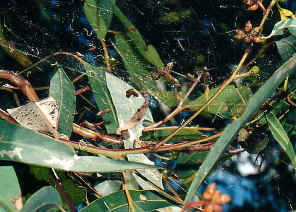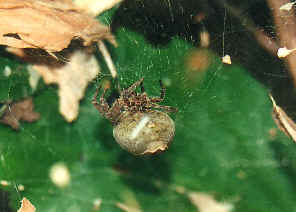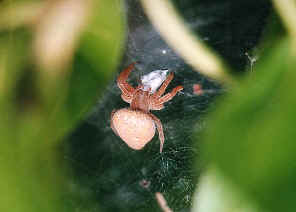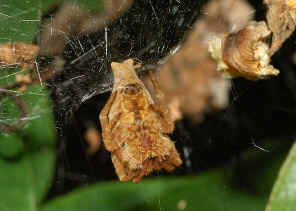|
| |
FAMILY ARANEIDAE
- This page contains pictures and information about Pan-web Spiders that
we found in the Brisbane area, Queensland, Australia.
-
 - leg to leg 15mm
-
- The Pan-web Spiders are pale brown to dark grey in colour. We easily found
this spider in Brisbane Botanic Gardens. The spider builds web similar to Tent
Spiders but with different shape. Instead of tent-shaped web, This spider's webs
are in pan shape. So we call them Pan-web Spiders.
-
-


-
- The spiders build pan-shaped webs in permanent site. Their webs are about
0.5m in diameter built among plants horizontally. There are many supporting silk
on the top of the web to discourage prey or intruders enter from the top. In day
and night the spiders hang at the middle of the web, waiting for prey.
-
  -
- Because the web is horizontally built and is permanent (not re-build everyday
like some other spiders, there are many plant
materials fall and collected on to the web. The spiders spend quite a lot of
time on cleaning their web. Usually they do the cleaning at night. They remove
the small dirt, cut and drop the larger items. Then repair every part of the web
to almost perfect. They seldom rebuild their webs from new.
-

 -
- As most other web weaving spiders, the Pan-web Spiders are very shy. They will
run to their retreat even a very minor disturb. Not like the Tent Spider with
retreat at the web centre, the Pan-web Spiders retreat is some where near the edge
of the web. Once they are hiding, because of their camouflaged colour, they are
hard to be found. They may stay in their retreat for hours.
-

 -
- The spider leaves some fallen dry plant materials on the web which enhance
the camouflage.
-

 -
- Mid summer is their reproduction season. The female make the egg sac in their
retreat. The egg sac is a olive-shaped silken ball. After the spiders make the
egg sac, they will 24hrs guarding the egg sac. In this period, they do not come
back to the web and do not feed until their offspring hatch. It takes about two
to three weeks. After the spiderlings hatched, the mother spiders return to
their web. The spiderlings will remain in the retreat for a few weeks.
- Reference:
- 1. Cyrtophora
exanthematica - The
Find-a-spider Guide for Australian Spiders, University of Southern
Queensland, 2007.
- 2. Spiders
of Australia: An Introduction to Their Classification, Biology &
Distribution - Hawkeswood T, Pensoft Pub, 2003, p119.
Back to top.
[ Up ] [ Garden Orb Web Spider ] [ Sliver Lobed Spider ] [ Brown Lobed Spider ] [ Scorpion-tailed Spider ] [ Leaf Nesting Spider ] [ Bush Orb Weaver ] [ Triangular Spider ] [ Triangular Spider II ] [ Tent Spider ] [ Russian Tent Spider ] [ Pan-web Spider ] [ St Andrew's Cross Spider ] [ Banded Orb-weaving Spider ] [ Gumtree Trunk Weaver ] [ Two-spined Spider ] [ Bird-dropping Spider ] [ Jewel Spider ] [ Wrap-around Spider ] [ Tree-stump Spider ]
|











